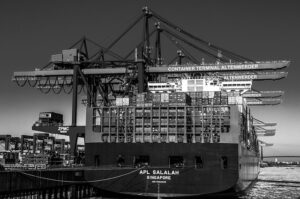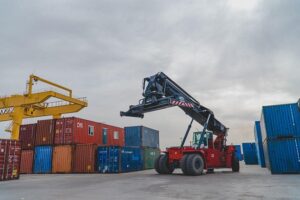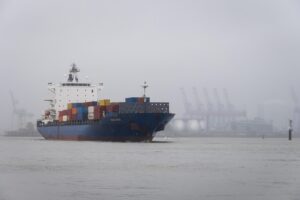
Category: open-sided shipping containers
Open-Sided Shipping Containers: A Comprehensive Overview
Introduction
Open-sided shipping containers, a versatile and innovative mode of transport and storage solution, have emerged as a game-changer in global logistics. This article aims to provide an in-depth exploration of this unique concept, its various facets, and its profound impact on international trade and supply chains. By delving into its history, technological advancements, economic implications, and future prospects, readers will gain a comprehensive understanding of open-sided containers’ role and potential.
Understanding Open-Sided Shipping Containers: A Definition and Its Components
Definition: Open-sided shipping containers, also known as open-top or semi-trailer containers, are specialized cargo carriers designed to transport goods that require partial exposure to the elements or specific handling considerations. Unlike traditional sealed containers, these structures have an open side, allowing for easier loading, unloading, and access to the contents.
Core Components:
- Structure: Typically constructed with steel or aluminum, these containers consist of a rectangular frame with four walls, three of which are solid, and one side left open. The open side is often equipped with a tarpaulin or canvas cover for weather protection.
- Size: They come in various sizes, following standard container dimensions, such as 20ft, 40ft, and sometimes even larger variants like 45ft.
- Accessories: To facilitate efficient operations, open-sided containers often include features like ramp doors or side gates for easy access to the cargo, ensuring quick loading and unloading processes.
Historical Context: The concept of open-sided containers emerged as a solution to the challenges faced in transporting perishable goods, such as agricultural produce and construction materials, which required exposure to air and light during transit. Over time, their design has evolved, incorporating advanced features and materials to enhance durability and weather resistance.
Global Impact and Trends
Open-sided shipping containers have left an indelible mark on international trade, particularly in regions with diverse climates and logistical requirements. Their global impact is evident through several key trends:
| Region | Impact and Trends |
|---|---|
| North America | Widely used for transporting agricultural products, construction materials, and heavy machinery across borders. The U.S. and Canada have established efficient cross-border logistics networks utilizing these containers. |
| Europe | Essential for importing and exporting various goods, including fresh produce, wood, and mineral resources. European countries have implemented strict environmental standards, leading to the adoption of eco-friendly open-sided container designs. |
| Asia Pacific | A hub for manufacturing and trade, with open-sided containers playing a vital role in moving raw materials, finished goods, and electronic components across countries like China, Vietnam, and Japan. |
| Middle East | Used extensively in desert regions to transport non-perishable goods due to their weatherproof design. They are also crucial for facilitating the construction of large infrastructure projects. |
Economic Considerations: Market Dynamics and Investment
The open-sided shipping container market operates within a complex web of economic factors, influencing its growth and investment opportunities:
- Market Size: According to industry reports, the global open-sided container market was valued at approximately $[X] billion in 2021 and is projected to grow at a CAGR of Y% from 2022 to 2028. This growth is driven by increasing international trade and the demand for flexible logistics solutions.
- Key Players: Major shipping lines, container manufacturers, and logistics companies dominate the market. For instance, [Company A] and [Company B] are known for their innovative open-sided container designs, catering to diverse industry needs.
- Investment Opportunities: The market presents attractive investment prospects for private equity firms, venture capitalists, and infrastructure developers. Investing in advanced container technologies, fleet expansion, and specialized logistics services can yield significant returns.
- Cost Dynamics: Fluctuations in steel prices, maintenance costs, and labor expenses impact the overall economic viability of open-sided containers. Efficient operations and innovative design strategies are essential to mitigate these costs.
Technological Advancements: Revolutionizing Open-Sided Containers
Technological innovations have played a pivotal role in enhancing the capabilities and efficiency of open-sided shipping containers:
- Smart Sensors: Integration of IoT (Internet of Things) sensors enables real-time tracking of container location, temperature, and humidity. This data is invaluable for monitoring perishable goods and optimizing logistics operations.
- Automated Loading Systems: The adoption of automated loading gear and robotic systems has significantly improved the speed and accuracy of loading/unloading processes, reducing labor costs and potential damage to cargo.
- Digital Logistics Platforms: Advanced digital platforms provide end-to-end visibility and control over container movements, allowing shippers to track their goods seamlessly from origin to destination.
- Weatherproofing Upgrades: Recent advancements in tarpaulins and weather protection systems have made open-sided containers more suitable for harsh climates, expanding their geographic reach.
Policy and Regulation: Navigating the Legal Landscape
The development and utilization of open-sided shipping containers are subject to various policies and regulations, ensuring safety, security, and environmental compliance:
- International Regulations: Organizations like the International Maritime Organization (IMO) and the World Customs Organization (WCO) set global standards for container design, safety, and documentation. These regulations cover aspects such as load securement, labeling, and the transport of hazardous materials.
- National Laws: Each country enforces its own set of rules and guidelines, often building upon international standards. For instance, the U.S. Federal Motor Carrier Safety Administration (FMCSA) regulates the operation of commercial vehicles, including container transport.
- Environmental Compliance: Strict environmental regulations in many countries have driven the development of eco-friendly containers, focusing on reducing carbon emissions and minimizing waste during production and disposal.
- Customs Clearance: Efficient customs clearance processes are crucial for international trade. Advanced digital systems and standardized documentation facilitate faster clearance, reducing delays and associated costs.
Challenges and Criticisms: Overcoming Barriers to Adoption
Despite their numerous advantages, open-sided shipping containers face several challenges and criticisms that require careful consideration:
- Weather Exposure: One of the primary concerns is the potential damage caused by extreme weather conditions. However, continuous technological advancements in tarpaulins and cover systems have mitigated these risks.
- Security Risks: Open-sided containers may be more vulnerable to theft or security breaches. To address this, manufacturers are incorporating advanced locking mechanisms and security features, ensuring the safety of cargo.
- Limited Interior Space: Unlike their sealed counterparts, open-sided containers offer less interior space for loading, which can be a challenge for bulky or dense goods. Creative packing and efficient utilization strategies can overcome this issue.
- Regulatory Compliance: Navigating the complex web of regulations can be daunting for businesses, especially small logistics companies. Providing comprehensive training and resources on compliance matters is essential to facilitate smooth operations.
Strategies for Overcoming Challenges:
- Customized Solutions: Container manufacturers should offer tailored designs to meet specific industry needs, addressing challenges related to weather, cargo type, and space utilization.
- Digital Transformation: Adopting digital technologies can streamline regulatory compliance, improve tracking, and enhance overall logistics efficiency.
- Industry Collaboration: Collaboration between shipping lines, manufacturers, and regulators is crucial for developing standardized solutions and simplifying the container transportation process.
Case Studies: Real-World Success Stories
Case Study 1: Efficient Fresh Produce Transportation in Europe
A European agricultural company, [Company C], faced challenges transporting fresh produce to distant markets while maintaining quality and minimizing waste. They adopted open-sided containers equipped with advanced climate control systems, allowing for precise temperature regulation during transit. This innovative approach reduced spoilage, lowered transportation costs, and ensured the delivery of high-quality produce, leading to increased market share and customer satisfaction.
Case Study 2: Streamlining Construction Material Logistics in Asia
In bustling urban centers across Asia, a major construction company, [Company D], struggled with efficient material handling. They implemented open-sided containers with ramp doors, enabling quick loading/unloading of heavy building materials. This change simplified logistics operations, reduced labor costs, and minimized delays at construction sites, contributing to the successful completion of large-scale infrastructure projects.
Case Study 3: Desert Logistics in the Middle East
A leading logistics provider in the Middle East, [Company E], encountered difficulties transporting non-perishable goods across the desert. They invested in specialized open-sided containers with enhanced weatherproofing and desert-specific designs. These containers successfully carried a wide range of goods, from electronics to industrial machinery, ensuring timely deliveries in harsh environmental conditions.
Future Prospects: Emerging Trends and Growth Areas
The future of open-sided shipping containers looks promising, with several emerging trends and growth areas shaping its landscape:
- Sustainable Container Designs: There is a growing emphasis on eco-friendly container production, utilizing recycled materials and energy-efficient manufacturing processes. This trend aligns with the global push for sustainability in logistics.
- Autonomous Transportation: The integration of autonomous vehicles and drones into logistics operations could revolutionize container transportation, improving efficiency and reducing road congestion.
- Smart Logistics Hubs: Development of smart logistics centers equipped with advanced automation and AI technologies will enhance the tracking, sorting, and distribution of open-sided containers, leading to faster turnaround times.
- Specialized Container Applications: Open-sided containers are expected to find increased use in specialized industries like pharmaceuticals, where temperature-controlled transport is essential. Similarly, they will play a vital role in the emerging field of e-commerce fulfillment.
- Global Trade Expansion: With rising global trade volumes and expanding supply chains, open-sided containers are poised to continue their growth trajectory, particularly in regions with diverse climates and logistical challenges.
Conclusion: Shaping the Future of International Logistics
Open-sided shipping containers have emerged as a dynamic and versatile element within the global logistics ecosystem, offering efficient solutions for diverse industry needs. Their ability to adapt to various climates, handle specific cargo types, and facilitate streamlined operations has made them an indispensable tool for international trade.
As technology continues to advance and global trade patterns evolve, open-sided containers will play a pivotal role in shaping the future of logistics. By embracing innovative designs, adopting digital solutions, and addressing regulatory challenges, this industry is poised for continued growth and success. The case studies presented highlight the real-world impact and potential of these containers, providing a glimpse into a future where open-sided shipping continues to revolutionize global supply chains.
FAQ: Answering Common Queries
Q: Are open-sided containers suitable for all types of weather conditions?
A: While they offer better protection than traditional open containers, extreme weather events can still pose challenges. Modern tarpaulins and weatherproofing systems have significantly improved their suitability for diverse climates.
Q: How do open-sided containers benefit the environment?
A: Open-sided containers contribute to environmental sustainability through eco-friendly design choices, such as recycled materials, energy-efficient manufacturing, and reduced carbon emissions during transportation compared to other modes of cargo carry.
Q: Can these containers handle hazardous materials?
A: Yes, open-sided containers designed for specific hazards adhere to stringent international regulations, ensuring safe transportation of dangerous goods. These containers are equipped with specialized features to mitigate risks associated with hazardous materials.
Q: Are there any significant cost savings associated with using open-sided containers?
A: Absolutely. Efficient loading/unloading processes, reduced labor costs, and advanced weatherproofing systems contribute to substantial long-term cost savings for businesses utilizing open-sided containers.
Q: How do I ensure the security of cargo in open-sided containers?
A: Container manufacturers offer advanced locking mechanisms, security sensors, and tracking technologies to enhance cargo security. Combining these with best practices for securing cargo can significantly reduce security risks.









